Gamifying Community Education for Enhanced Disaster Resilience: An Effectiveness Testing Study from Australia
Abstract
:1. Introduction
2. Literature Background
2.1. Traditional Disaster Education Methods
2.2. Contemporary Disaster Education Methods
3. Research Design
3.1. Case Study
3.2. Social Media Analytics
3.3. Gamification in Practice
3.4. Survey Design
4. Results
4.1. Public Perceptions on Bushfire Disaster Education
4.1.1. Perception Clusters
4.1.2. Sentiments and Attitudes
4.2. Survey Participants Perspectives on Gamified Bushfire Disaster Education
4.2.1. Perceptions on Gamification
4.2.2. Means to Improve Effectiveness
5. Discussion
5.1. How Do the Public Perceive Traditional Methods in Disaster Education Practices?
5.2. How Effective Is the Gamification Method in Disaster Education?
6. Conclusions
Author Contributions
Funding
Informed Consent Statement
Data Availability Statement
Conflicts of Interest
References
- Boon, H.; Pagliano, P.J. Disaster education in Australian schools. Aust. J. Environ. Educ. 2014, 30, 187–197. [Google Scholar] [CrossRef]
- Ludwig, T.; Kotthaus, C.; Reuter, C.; Van Dongen, S.; Pipek, V. Situated crowdsourcing during disasters. Int. J. Hum. Comput. Stud. 2017, 1, 103–121. [Google Scholar] [CrossRef]
- Saja, A.A.; Teo, M.; Goonetilleke, A.; Ziyath, A.M. An inclusive and adaptive framework for measuring social resilience to disasters. Int. J. Disaster Risk Reduct. 2018, 28, 862–873. [Google Scholar] [CrossRef]
- Dufty, N. Disaster Education, Communication, and Engagement; John Wiley & Sons: New York, NY, USA, 2020; pp. 156–198. [Google Scholar]
- Sendai Framework for Disaster Risk Reduction 2015–2030. Available online: https://www.unisdr.org/we/inform/publications/43291 (accessed on 24 September 2020).
- Preston, J. What Is Disaster Education? Brill Sense: Paderborn, Germany, 2012; pp. 342–401. [Google Scholar]
- Houston, J.B.; Hawthorne, J.; Perreault, M.F.; Park, E.H.; Goldstein-Hode, M.; Halliwell, M.R.; Griffith, S.A. Social media and disasters: A functional framework for social media use in disaster planning, response, and research. Disasters 2015, 39, 1–22. [Google Scholar] [CrossRef] [PubMed]
- Kankanamge, N.; Yigitcanlar, T.; Goonetilleke, A. How engaging are disaster management related social media channels? Int. J. Disaster Risk Reduct. 2020, 48, 101571. [Google Scholar] [CrossRef]
- Dufty, N. A new approach to disaster education. In Proceedings of the International Emergency Management Society Annual Conference, Manila, Philippines, 13–16 November 2018. [Google Scholar]
- Yigitcanlar, T.; Corchado, J.; Mehmood, R.; Li, R.; Mossberger, K.; Desouza, K. Responsible urban innovation with local government artificial intelligence (AI): A conceptual framework and research agenda. J. Open Innov. Technol. Mark. Complex. 2021, 7, 71. [Google Scholar] [CrossRef]
- Shaw, R.; Shiwaku, K.; Takeuchi, Y. Disaster Education; Emerald: Bingley, UK, 2011; pp. 56–88. [Google Scholar]
- Kankanamge, N.; Yigitcanlar, T.; Goonetilleke, A.; Kamruzzaman, M. How can gamification be incorporated into disaster emergency planning? Int. J. Disaster Risk Reduct. 2020, 11, 481–506. [Google Scholar] [CrossRef]
- Australian Institute for Disaster Resilience. Available online: https://knowledge.aidr.org.au/resources/bushfire-wooroloo-perth-hills-western-australia-2021/ (accessed on 26 May 2022).
- Rebolledo-Mendez, G.; Avramides, K.; de Freitas, S.; Memarzia, K. Societal impact of a serious game on raising public awareness. In Proceedings of the 2009 ACM SIGGRAPH Symposium on Video Games, New Orleans, LA, USA, 3–7 August 2009. [Google Scholar]
- Breuer, R.; Sewilam, H.; Nacken, H.; Pyka, C. Exploring the application of a flood risk management serious game platform. Environ. Earth Sci. 2017, 76, 93. [Google Scholar] [CrossRef]
- Khoury, M.; Gibson, M.J.; Savic, D.; Chen, A.S.; Vamvakeridou-Lyroudia, L.; Langford, H.; Wigley, S. A serious game designed to explore and understand the complexities of flood mitigation options in urban-rural catchments. Water 2018, 10, 1885. [Google Scholar] [CrossRef] [Green Version]
- Tomaszewski, B.; Schwartz, D.I. Critical spatial thinking and serious geogames. In Proceedings of the AGILE Workshop on Geogames and Geoplay, Wageningen, The Netherlands, 9 May 2017. [Google Scholar]
- Wahyudin, D.; Hasegawa, S.; Kamaludin, A. Students’ viewpoint of computer game for training in Indonesian universities and high schools. Educ. Inf. Technol. 2017, 22, 1927–1945. [Google Scholar] [CrossRef]
- Stop Disasters. Available online: http://www.stopdisastersgame.org (accessed on 10 May 2022).
- Meesters, K.; Olthof, L.; Van de Walle, B. Disaster in my backyard. In Proceedings of the European Conference on Games Based Learning, Amsterdam, The Netherlands, 9–10 October 2014. [Google Scholar]
- Wells, S.; Kotkanen, H.; Schlafli, M.; Gabrielli, S.; Masthoff, J.; Jylhä, A.; Forbes, P. Towards an applied gamification model for tracking, managing and encouraging sustainable travel behaviours. ICST Trans. Ambient. Syst. 2014, 1, e2. [Google Scholar] [CrossRef]
- Landers, R. Developing a theory of gamified learning: Linking serious games and gamification of learning. Simul. Gaming 2014, 45, 752–768. [Google Scholar] [CrossRef]
- Rodela, R.; Ligtenberg, A.; Bosma, R. Conceptualizing serious games as a learning-based intervention in the context of natural resources and environmental governance. Water 2019, 11, 245. [Google Scholar] [CrossRef] [Green Version]
- Kankanamge, N.; Yigitcanlar, T.; Goonetilleke, A.; Kamruzzaman, M. Determining disaster severity through social media analysis. Int. J. Disaster Risk Reduct. 2020, 42, 101360. [Google Scholar] [CrossRef]
- Liu, S.B. Crisis crowdsourcing framework. Comput. Support. Coop. Work 2014, 23, 389–443. [Google Scholar] [CrossRef]
- Aubert, A.H.; Bauer, R.; Lienert, J. A review of water-related serious games to specify use in environmental multi-criteria decision analysis. Environ. Model. Softw. 2018, 105, 64–78. [Google Scholar] [CrossRef]
- Aubert, A.H.; Lienert, J. Gamified online survey to elicit citizens’ preferences and enhance learning for environmental decisions. Environ. Model. Softw. 2019, 111, 1–12. [Google Scholar] [CrossRef]
- Gardoni, P.; Murphy, C. Gauging the societal impacts of natural disasters using a capability approach. Disasters 2010, 34, 619–636. [Google Scholar] [CrossRef]
- Australian Government Bureau of Meteorology. Available online: http://www.bom.gov.au/state-of-the-climate/State-of-the-Climate-2018.pdf (accessed on 10 May 2022).
- Kelly, B.; Ronan, K.R. Preparedness for natural hazards. Nat. Hazards 2018, 91, 19–35. [Google Scholar] [CrossRef]
- Johnson, V.A.; Ronan, K.R.; Johnston, D.M.; Peace, R. Evaluations of disaster education programs for children: A methodological review. Int. J. Disaster Risk Reduct. 2014, 9, 107–123. [Google Scholar] [CrossRef]
- Dufty, N. Learning for disaster resilience. In Proceedings of the Australian & New Zealand Disaster and Emergency Management Conference, Brisbane, Australia, 16–18 April 2012. [Google Scholar]
- Ryan, R.M.; Deci, E.L. Intrinsic and extrinsic motivations. Contemp. Educ. Psychol. 2000, 25, 54–67. [Google Scholar] [CrossRef] [PubMed]
- Arinta, R.R.; Emanuel, A.W. Effectiveness of gamification for flood emergency planning in the disaster risk reduction area. Int. J. Eng. Pedagog. 2020, 10, 108–124. [Google Scholar] [CrossRef]
- Zhao, Y.; Tang, J. Exploring the motivational affordances of Danmaku video sharing websites. In Proceedings of the International Conference on Human-Computer Interaction, Toronto, ON, Canada, 17–22 July 2016. [Google Scholar]
- Kankanamge, N.; Yigitcanlar, T.; Goonetilleke, A.; Kamruzzaman, M. Can volunteer crowdsourcing reduce disaster risk? Int. J. Disaster Risk Reduct. 2019, 35, 101097. [Google Scholar] [CrossRef]
- Holley, R. Crowdsourcing. D-Lib Mag. 2010, 16, 1–10. [Google Scholar] [CrossRef]
- Neef, M.; van Dongen, K.; Rijken, M. Community-based comprehensive recovery. Int. J. Inf. Syst. Crisis Response Manag. 2013, 1, 8–32. [Google Scholar]
- Crowley, D.N.; Breslin, J.G.; Corcoran, P.; Young, K. Gamification of citizen sensing through mobile social reporting. In Proceedings of the 2012 IEEE International Games Innovation Conference, Rochester, NY, USA, 7–9 September 2012. [Google Scholar]
- Goodchild, M.F.; Glennon, J.A. Crowdsourcing geographic information for disaster response: A research frontier. Int. J. Digit. Earth 2010, 3, 231–241. [Google Scholar] [CrossRef]
- Deterding, S.; Dixon, D.; Khaled, R.; Nacke, L. From game design elements to gamefulness. In Proceedings of the 15th International Academic MindTrek Conference: Envisioning Future Media Environments, Online, 28 September 2011. [Google Scholar]
- Kim, S. Decision support model for introduction of gamification solution using AHP. Sci. World J. 2014, 1, 714239. [Google Scholar] [CrossRef]
- Prestopnik, N.; Crowston, K.; Wang, J. Gamers, citizen scientists, and data. Comput. Hum. Behav. 2017, 1, 254–268. [Google Scholar] [CrossRef] [Green Version]
- Onencan, A.; Van de Walle, B.; Enserink, B.; Chelang’a, J.; Kulei, F. WeShareIt Game. Procedia Eng. 2016, 159, 307–315. [Google Scholar] [CrossRef] [Green Version]
- Suarez, P. Rethinking engagement. Int. J. Geogr. Inf. Syst. 2015, 4, 1729–1749. [Google Scholar] [CrossRef]
- Bourgonjon, J.; Valcke, M.; Soetaert, R.; Schellens, T. Students’ perceptions about the use of video games in the classroom. Comput. Educ. 2010, 54, 1145–1156. [Google Scholar] [CrossRef]
- Felicio, S.; Silva, V.; Dargains, A.; Souza, P.; Sampaio, F.; de Carvalho, P.; Gomes, J.; Borges, M. Stop disasters game experiment with elementary school students in Rio de Janeiro: Building safety culture. In Proceedings of the 11th International Conference on Information Systems for Crisis Response and Management, ISCRAM, University Park, PA, USA, 18–21 May 2014. [Google Scholar]
- Seaborn, K.; Fels, D.I. Gamification in theory and action. Int. J. Hum. Comput. Stud. 2015, 74, 14–31. [Google Scholar] [CrossRef]
- Chen, C. Gamification in a Volunteered Geographic Information Context with Regard to Contributors’ Motivations: A Case Study of OpenStreetMap. Master’s Thesis, University of Waterloo, Waterloo, ON, Canada, 2017. [Google Scholar]
- McKenzie, G. Gamification and location-based services. In Proceedings of the Workshop on Cognitive Engineering for Mobile GIS, Belfast, ME, USA, 12 September 2011. [Google Scholar]
- Martí, I.G.; Rodríguez, L.E.; Benedito, M.; Trilles, S.; Beltrán, A.; Díaz, L.; Huerta, J. Mobile application for noise pollution monitoring through gamification techniques. In Proceedings of the International Conference on Entertainment Computing, Heidelberg, Germany, 26–29 September 2012. [Google Scholar]
- Gnat, M.; Leszek, K.; Olszewski, R. The use of geoinformation technology, augmented reality and gamification in the urban modeling process. In Proceedings of the International Conference on Computational Science and Its Applications, Online, 12 July 2016. [Google Scholar]
- Yoon, K. The gamification of mobile communication among young smartphone users in Seoul. Asiascape Digit. Asia 2016, 3, 60–78. [Google Scholar] [CrossRef]
- Burston, J.; Ware, D.; Tomlinson, R. The real-time needs of emergency managers for tropical cyclone storm tide forecasting. Nat. Hazards 2015, 78, 1653–1668. [Google Scholar] [CrossRef]
- Sosko, S.; Dalyot, S. Crowdsourcing user-generated mobile sensor weather data for densifying static geosensor networks. Int. J. Geogr. Inf. Syst. 2017, 6, 61. [Google Scholar] [CrossRef] [Green Version]
- Mylonas, G.; Amaxilatis, D.; Pocero, L.; Markelis, I.; Hofstaetter, J.; Koulouris, P. Using an educational iot lab kit and gamification for energy awareness in European schools. In Proceedings of the Conference on Creativity and Making in Education, Online, 18 June 2018. [Google Scholar]
- Suwanmolee, S. The Gamification of COVID-19 Pandemic as an Active Learning Tool in Disaster Education. In Proceedings of the 6th UPI International Conference on TVET 2020, Online, 4 February 2021. [Google Scholar]
- Bell, N. Development in Australian bushfire prone areas. Environment 2019, 5, 1–14. [Google Scholar]
- Australian Association for Environmental Education. Available online: http://www.aaee.org.au/about (accessed on 10 September 2020).
- Blanchi, R.; Leonard, J.; Haynes, K.; Opie, K.; James, M.; de Oliveira, F.D. Environmental circumstances surrounding bushfire fatalities in Australia 1901–2011. Environ. Sci. Policy 2014, 37, 192–203. [Google Scholar] [CrossRef] [Green Version]
- Climate Council. Available online: https://www.climatecouncil.org.au/not-normal-climate-change-bushfire-web/ (accessed on 26 May 2022).
- Gray, B.J.; Weal, M.J.; Martin, D. Social media and disasters. Int. J. Inf. Syst. Crisis Response Manag. 2016, 8, 41–55. [Google Scholar] [CrossRef]
- Jung, J.Y.; Moro, M. Multi-level functionality of social media in the aftermath of the Great East Japan Earthquake. Disasters 2014, 38, 123–143. [Google Scholar] [CrossRef]
- Kryvasheyeu, Y.; Chen, H.; Obradovich, N.; Moro, E.; Van Hentenryck, P.; Fowler, J.; Cebrian, M. Rapid assessment of disaster damage using social media activity. Sci. Adv. 2016, 2, e1500779. [Google Scholar] [CrossRef] [Green Version]
- The Year on Twitter. Available online: https://blog.twitter.com/en_gb/a/en-gb/2013/2013-the-year-on-twitter.html (accessed on 12 September 2020).
- Dufty, N. A society-first approach to flood mitigation. In Proceedings of the 56th Floodplain Management Australia Conference, Nowra, Australia, 17–20 May 2016. [Google Scholar]
- Wattenberg, M.; Viégas, F.B. The word tree, an interactive visual concordance. IEEE Trans. Vis. Comput. Graph. 2008, 14, 1221–1228. [Google Scholar] [CrossRef]
- Lai, A.K.H.; Bin Noor Azhar, A.M.; Binti Bustam, A.; Tiong, X.T.; Chan, H.C.; Bin Ahmad, R.; Chew, K.S. A comparison between the effectiveness of a gamified approach with the conventional approach in point-of-care ultrasonographic training. BMC Med. Educ. 2020, 20, 263. [Google Scholar] [CrossRef]
- Woolwine, S.; Romp, C.R.; Jackson, B. Game on. J. Nurses Prof. Dev. 2019, 35, 255–260. [Google Scholar] [CrossRef]
- Gampell, A.V.; Gaillard, J.C.; Parsons, M.; Fisher, K. Beyond Stop Disasters 2.0. Environ. Hazards. 2017, 16, 180–191. [Google Scholar] [CrossRef]
- Olszewski, R.; Turek, A.; Laczynski, M. Urban Gamification as a Source of Information for Spatial Data Analysis and Predictive Participatory Modelling of a City’s Development. In Proceedings of the 5th International Conference on Data Management Technologies and Applications (DATA 2016), Setubal, Portugal, 24–26 July 2016. [Google Scholar]
- Pereira, G.; Prada, R.; Paiva, A. Disaster prevention social awareness. In Proceedings of the 6th International Conference on Games and Virtual Worlds for Serious Applications, Valletta, Malta, 9–12 September 2014. [Google Scholar]
- Social and Citizenship Education Association of Australia. Available online: https://www.sceaa.org.au/# (accessed on 10 September 2020).
- Bang, J.; Lee, Y.; Lee, Y.T.; Park, W. AR/VR based smart policing for fast response to crimes in safe city. In Proceedings of the IEEE International Symposium on Mixed and Augmented Reality Adjunct, Beijing, China, 10–18 October 2019. [Google Scholar]
- Anttiroiko, A.V. U-cities reshaping our future. AI Soc. 2013, 28, 491–507. [Google Scholar] [CrossRef]
- De Longueville, B.; Luraschi, G.; Smits, P.; Peedell, S.; De Groeve, T. Citizens as sensors for natural hazards. Geomatica 2010, 64, 41–59. Available online: https://publications.jrc.ec.europa.eu/repository/handle/JRC52420 (accessed on 18 May 2022).
- Goodchild, M.F. Citizens as sensors: The world of volunteered geography. GeoJournal 2007, 69, 211–221. [Google Scholar] [CrossRef] [Green Version]
- Sprake, J.; Rogers, P. Crowds, citizens and sensors. Pers Ubiquitous Comput. 2014, 18, 753–764. [Google Scholar] [CrossRef]
- Olszewski, R.; Wendland, A. Digital Agora–Knowledge acquisition from spatial databases, geoinformation society VGI and social media data. Land Use Policy 2021, 109, 105614. [Google Scholar] [CrossRef]
- Gao, H.; Barbier, G.; Goolsby, R. Harnessing the crowdsourcing power of social media for disaster relief. IEEE Intell. Syst. 2011, 26, 10–14. [Google Scholar] [CrossRef]
- De Albuquerque, J.P.; Herfort, B.; Brenning, A.; Zipf, A. A geographic approach for combining social media and authoritative data towards identifying useful information for disaster management. Int. J. Geogr. Inf. Syst. 2015, 29, 667–689. [Google Scholar] [CrossRef] [Green Version]
- Bennani, S.; Maalel, A.; Ben Ghezala, H. Adaptive gamification in E-learning: A literature review and future challenges. Comput. Appl. Eng. Educ. 2022, 30, 628–642. [Google Scholar] [CrossRef]
- IMD World Digital Competitiveness Ranking. Available online: https://dailynewshungary.com/imd-world-digital-competitiveness-ranking-2020-hungary-maintains-competitive-position/ (accessed on 10 September 2020).
- Kashian, A.; Rajabifard, A.; Richter, K.F.; Li, S.; Dragicevic, S. RoadPlex: A mobile VGI game to collect and validate data for POIs. ISPRS Ann. Photogramm. Remote Sens. Spat. Inf. Sci. 2014, 2, 55–60. [Google Scholar] [CrossRef] [Green Version]
- Yigitcanlar, T.; Kankanamge, N.; Regona, M.; Ruiz Maldonado, A.; Rowan, B.; Ryu, A.; Li, R. Artificial intelligence technologies and related urban planning and development concepts: How are they perceived and utilized in Australia? J. Open Innov. Technol. Mark. Complex 2020, 6, 187. [Google Scholar] [CrossRef]
- Naranjo-Zolotov, M.J. Collecting Data for Indoor Mapping of the University of Münster via a Location Based Game; Universitat Jaume I: Castellón de la Plana, Spain, 2015. [Google Scholar]
- McCartney, E.A.; Craun, K.J.; Korris, E.; Brostuen, D.A.; Moore, L.R. Crowdsourcing the national map. Cartogr. Geogr. Inf. Sci. 2015, 42, 54–57. [Google Scholar] [CrossRef]
- Kumar, D.; Shen, K.; Case, B.; Garg, D.; Alperovich, G.; Kuznetsov, D.; Gupta, R.; Durumeric, Z. All things considered. In Proceedings of the 28th USENIX Security Symposium, Berkeley, CA, USA, 14–16 August 2019. [Google Scholar]
- Baytiyeh, H. Can disaster risk education reduce the impacts of recurring disasters on developing societies? Educ. Urban Soc. 2018, 50, 230–245. [Google Scholar] [CrossRef]
- Catal, C.; Akbulut, A.; Tunali, B.; Ulug, E.; Ozturk, E. Evaluation of augmented reality technology for the design of an evacuation training game. Virtual Real. 2020, 24, 359–368. [Google Scholar] [CrossRef] [Green Version]
- Sezgin, S.; Yüzer, T.V. Analysing adaptive gamification design principles for online courses. Behav. Inf. Technol. 2022, 41, 485–501. [Google Scholar] [CrossRef]
- Yigitcanlar, T.; Wilson, M.; Kamruzzaman, M. Disruptive impacts of automated driving systems on the built environment and land use: An urban planner’s perspective. J. Open Innov. Technol. Mark. Complex. 2019, 5, 24. [Google Scholar] [CrossRef] [Green Version]
- Yigitcanlar, T.; Cugurullo, F. The sustainability of artificial intelligence: An urbanistic viewpoint from the lens of smart and sustainable cities. Sustainability 2020, 12, 8548. [Google Scholar] [CrossRef]
- Rincon-Flores, E.G.; Rodriguez-Rodriguez, N.; Santos-Guevara, B.N.; Sonoda, A.M.; Quintana-Cruz, H. Gamit! Interactive platform for gamification. In Proceedings of the 2022 IEEE Global Engineering Education Conference, Gammarth, Tunisia, 28–31 March 2022. [Google Scholar]
- Pancholi, S.; Yigitcanlar, T.; Guaralda, M. Public space design of knowledge and innovation spaces: Learnings from Kelvin Grove Urban Village, Brisbane. J. Open Innov. Technol. Mark. Complex. 2015, 1, 13. [Google Scholar] [CrossRef] [Green Version]
- Goonetilleke, A.; Yigitcanlar, T.; Ayoko, G.; Egodawatta, P. Sustainable Urban Water Environment: Climate, Pollution and Adaptation; Edward Elgar: Cheltenham, UK, 2014; pp. 245–346. [Google Scholar]
- Dospinescu, O.; Dospinescu, N. Perception over e-learning tools in higher education: Comparative study Romania and Moldova. In Proceedings of the IEEE 2020 International Conference, Bucharest & Timisoara, Romania, 1–4 May 2022. [Google Scholar] [CrossRef]
- Nadi-Ravandi, S.; Batooli, Z. Gamification in education: A scientometric, content and co-occurrence analysis of systematic review and meta-analysis articles. Educ. Inf. Technol. 2022, 1–32. [Google Scholar] [CrossRef]
- Filkov, A.I.; Ngo, T.; Matthews, S.; Telfer, S.; Penman, T.D. Impact of Australia’s catastrophic 2019/20 bushfire season on communities and environment. J. Saf. Sci. Resil. 2020, 1, 44–56. [Google Scholar] [CrossRef]
- Rawluk, A.; Ford, R.; Neolaka, F.; Williams, K. Public values for integration in natural disaster management and planning: A case study from Victoria, Australia. J. Environ. Manag. 2017, 185, 11–20. [Google Scholar] [CrossRef] [Green Version]
- The 2019–2020 Australian Bushfires. Available online: https://parlinfo.aph.gov.au/parlInfo/download/library/prspub/7234762/upload_binary/7234762.pdf (accessed on 10 September 2020).
- Arthur, R.; Boulton, C.A.; Shotton, H.; Williams, H.T. Social sensing of floods in the UK. PLoS ONE 2018, 13, e0189327. [Google Scholar] [CrossRef]
- Yigitcanlar, T. Smart city policies revisited: Considerations for a truly smart and sustainable urbanism practice. World Technopolis Rev. 2018, 7, 97–112. [Google Scholar]
- Scholefield, S.; Shepherd, L. Gamification techniques for raising cyber security awareness. In Proceedings of the International Conference on Human-Computer Interaction, Dundee, UK, 26–31 July 2019. [Google Scholar]
- Brauner, P.; Calero Valdez, A.; Schroeder, U.; Ziefle, M. Increase physical fitness and create health awareness through exergames and gamification. In Proceedings of the International Conference on Human Factors in Computing and Informatics, Berlin, Germany, 1–3 July 2013. [Google Scholar]
- Alloghani, M.; Hussain, A.; Al-Jumeily, D.; Aljaaf, A.; Mustafina, J. Gamification in e-governance: Development of an online gamified system to enhance government entities services delivery and promote public’s awareness. In Proceedings of the 5th International Conference on Information and Education Technology, Tokyo, Japan, 10–12 January 2017. [Google Scholar]
- Spanellis, A.; Harviainen, J.T. Transforming Society and Organizations through Gamification; Springer International Publishing: New York, NY, USA, 2021. [Google Scholar]
- Li, J.; Xia, H.; Qin, Y.; Fu, P.; Guo, X.; Li, R.; Zhao, X. Web GIS for sustainable education: Towards natural disaster education for high school students. Sustainability 2022, 14, 2694. [Google Scholar] [CrossRef]
- Park, W. Beyond the ‘two cultures’ in the teaching of disaster: Or how disaster education and science education could benefit each other. Educ. Philos. Theory 2020, 52, 1434–1448. [Google Scholar] [CrossRef]
- Shaw, R. Thirty years of science, technology, and academia in disaster risk reduction and emerging responsibilities. Int. J. Disaster Risk Sci. 2020, 11, 414–425. [Google Scholar] [CrossRef] [Green Version]
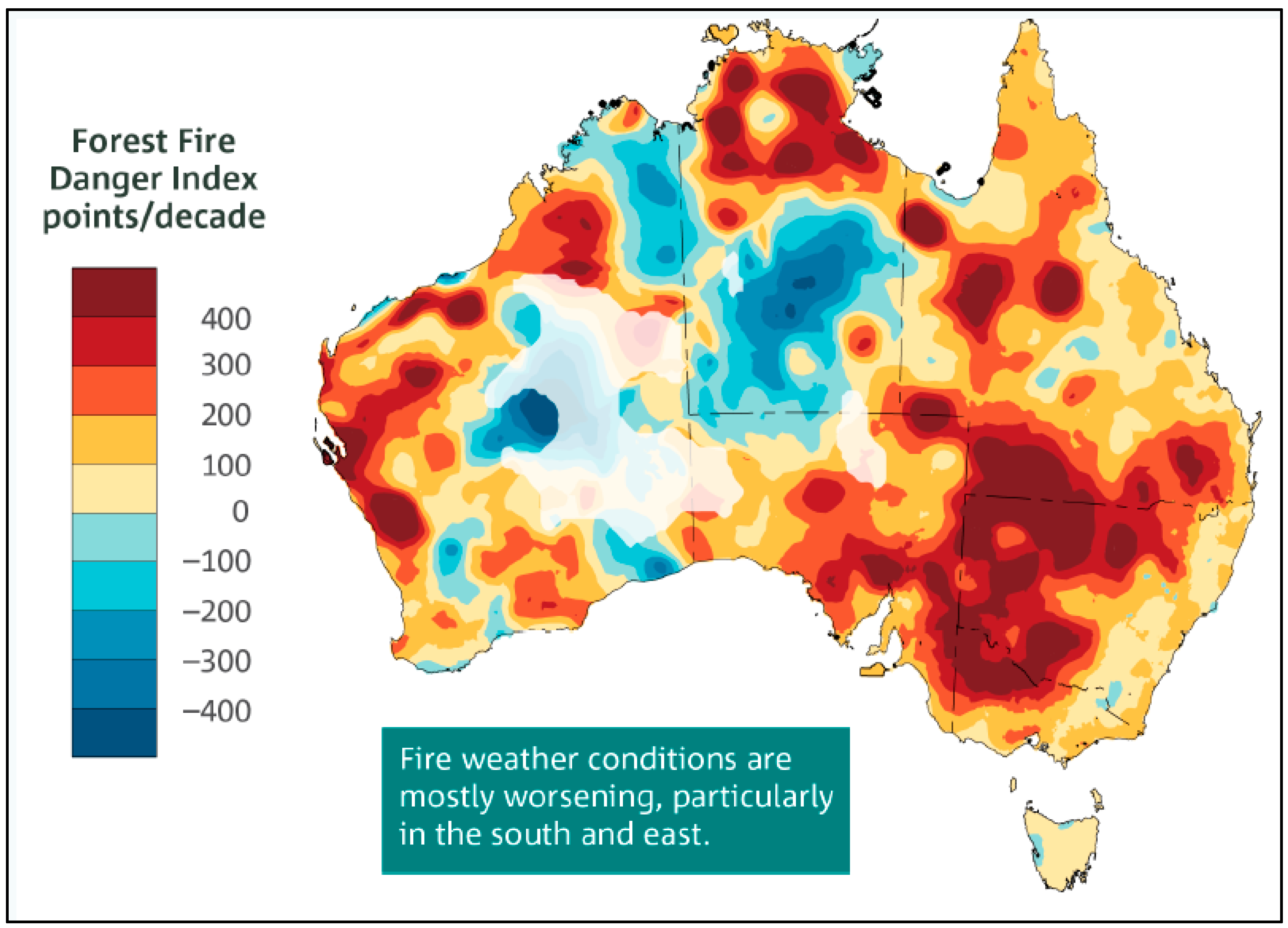
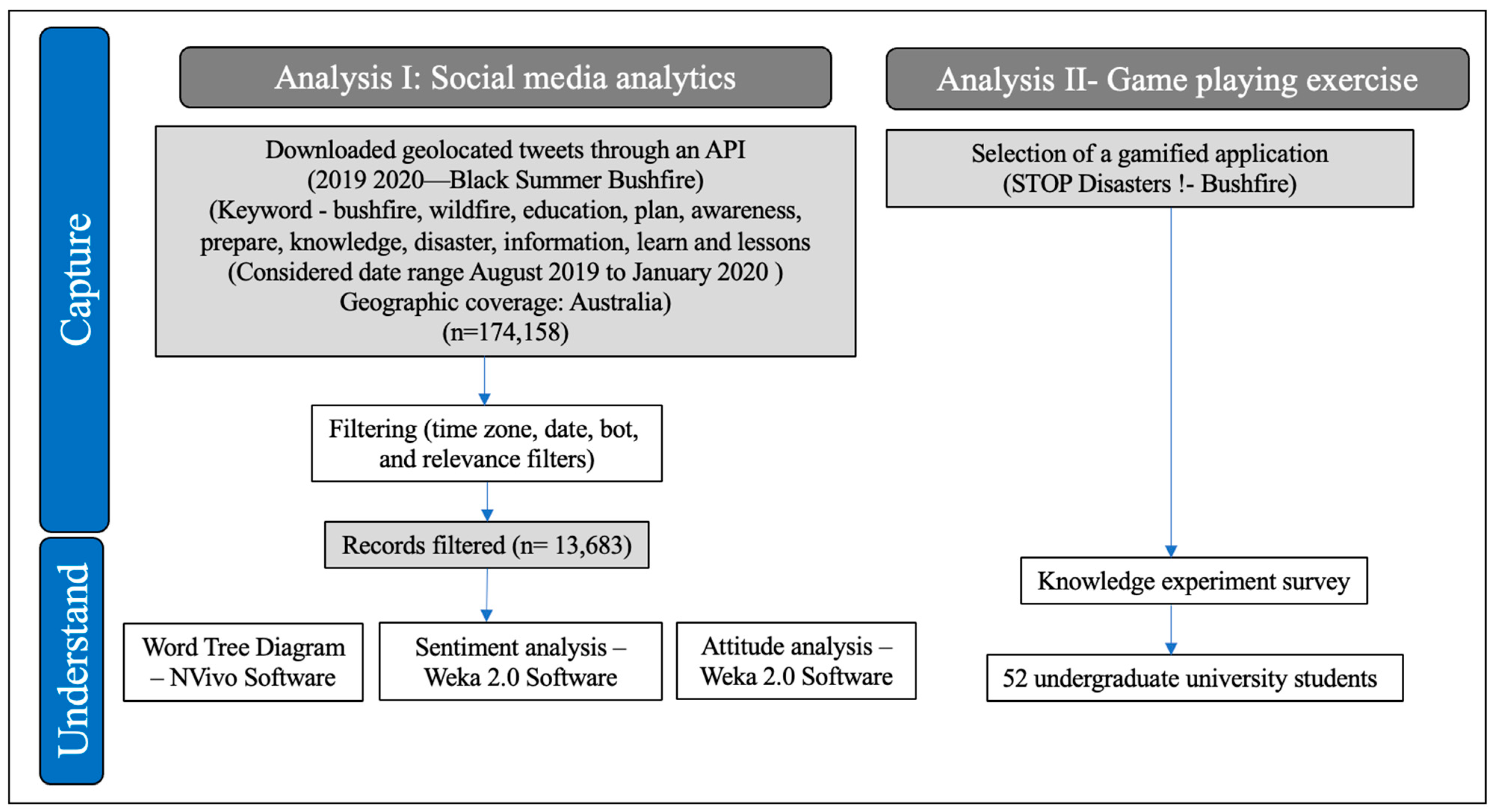
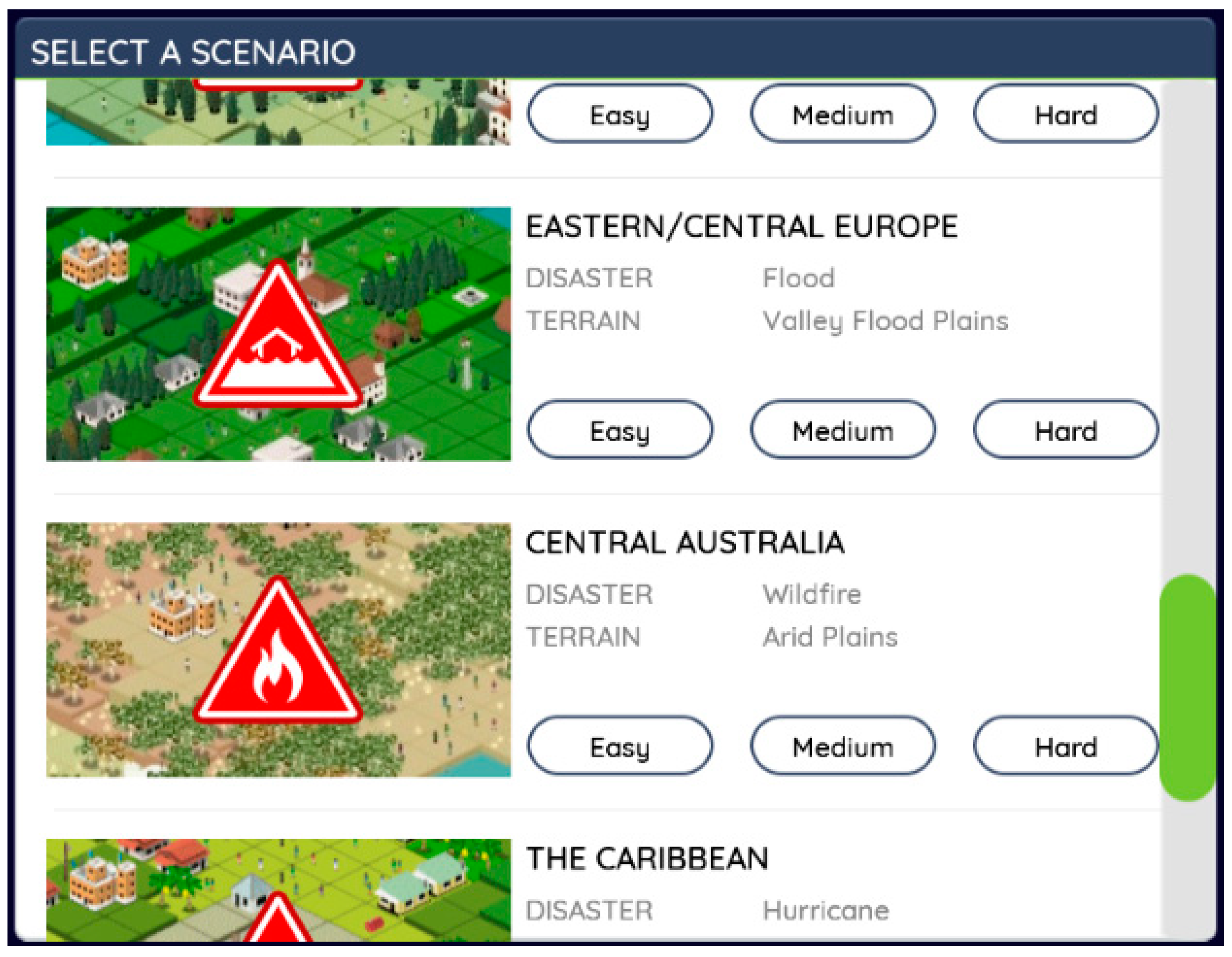
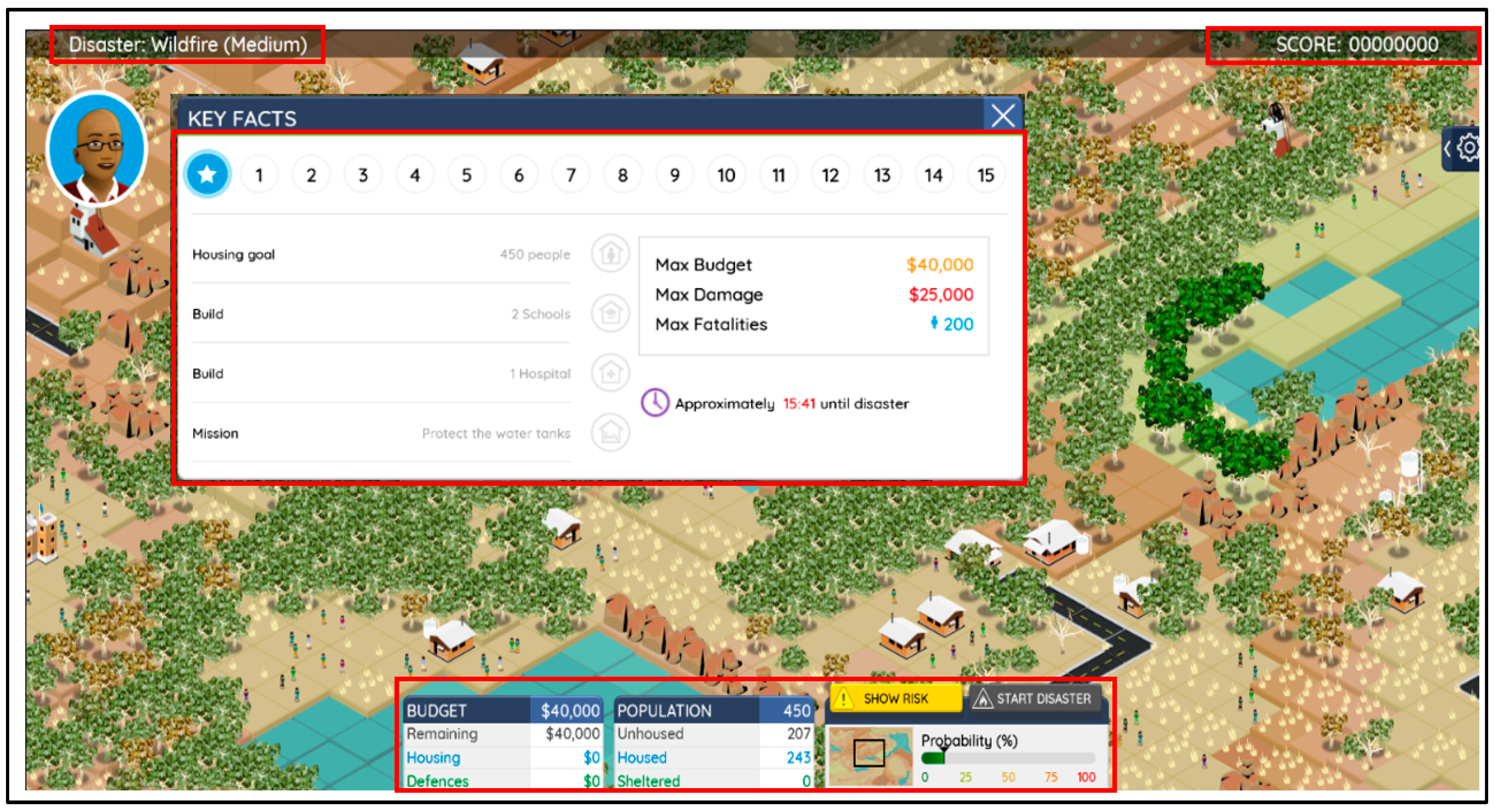
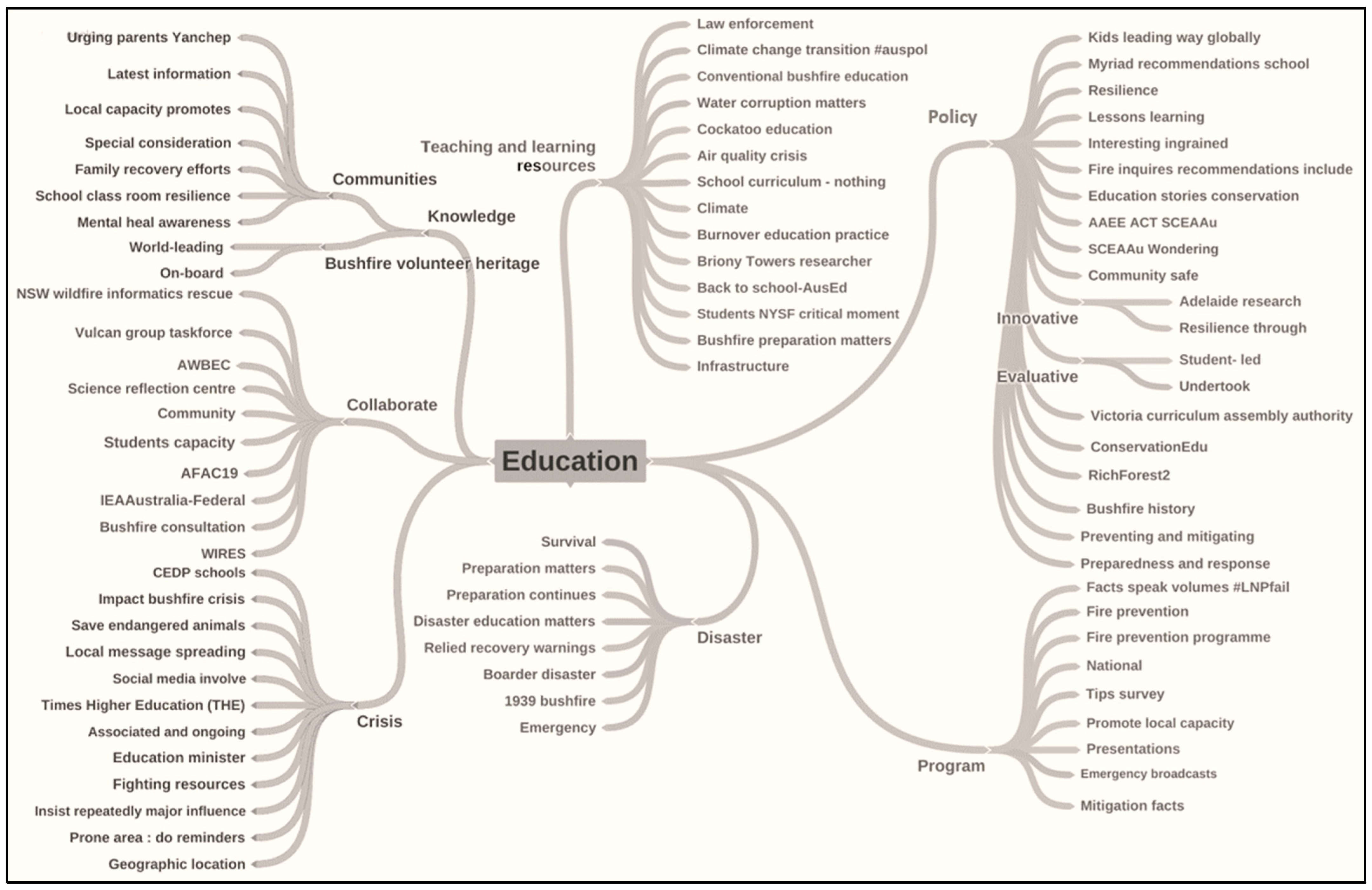
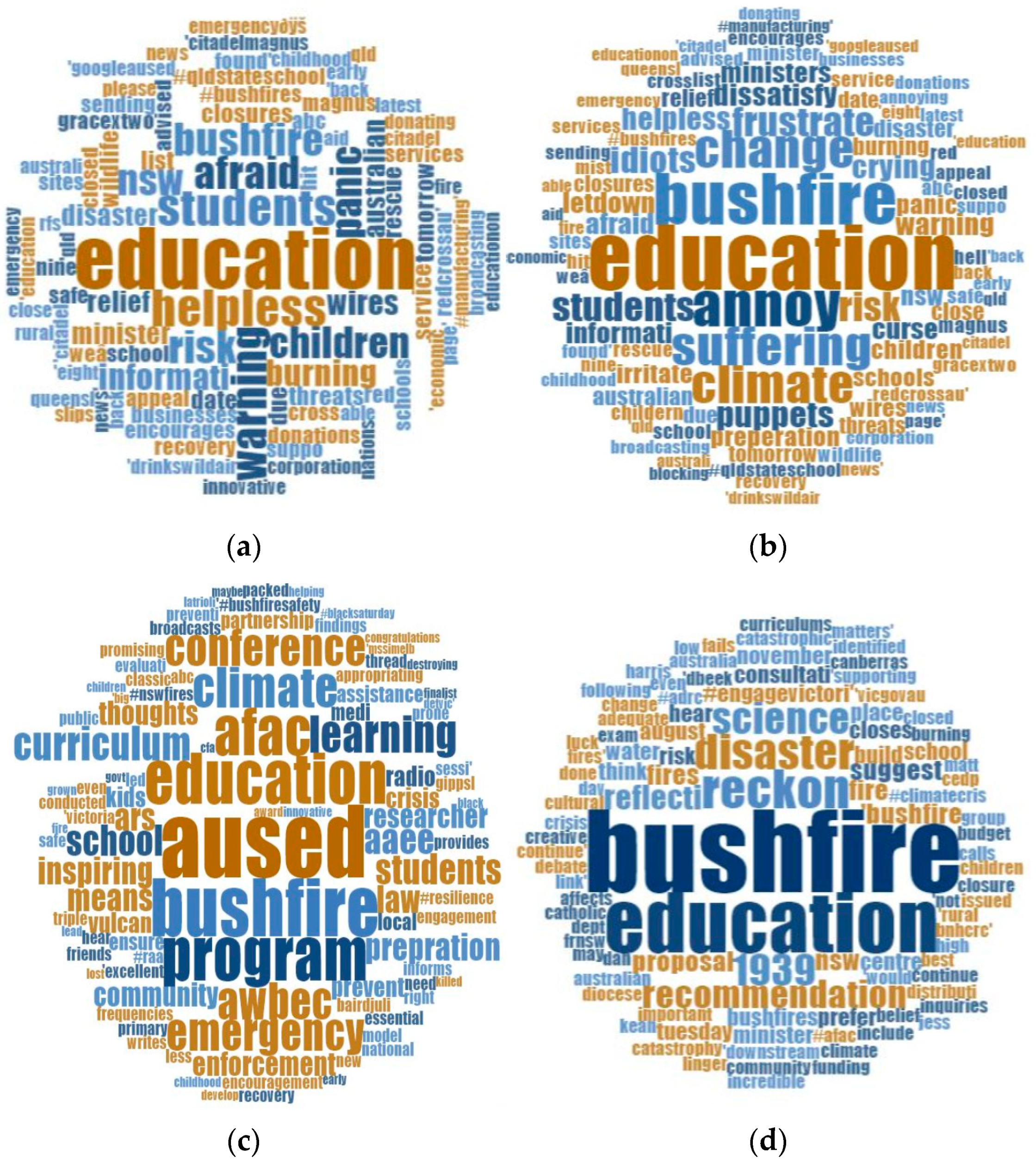
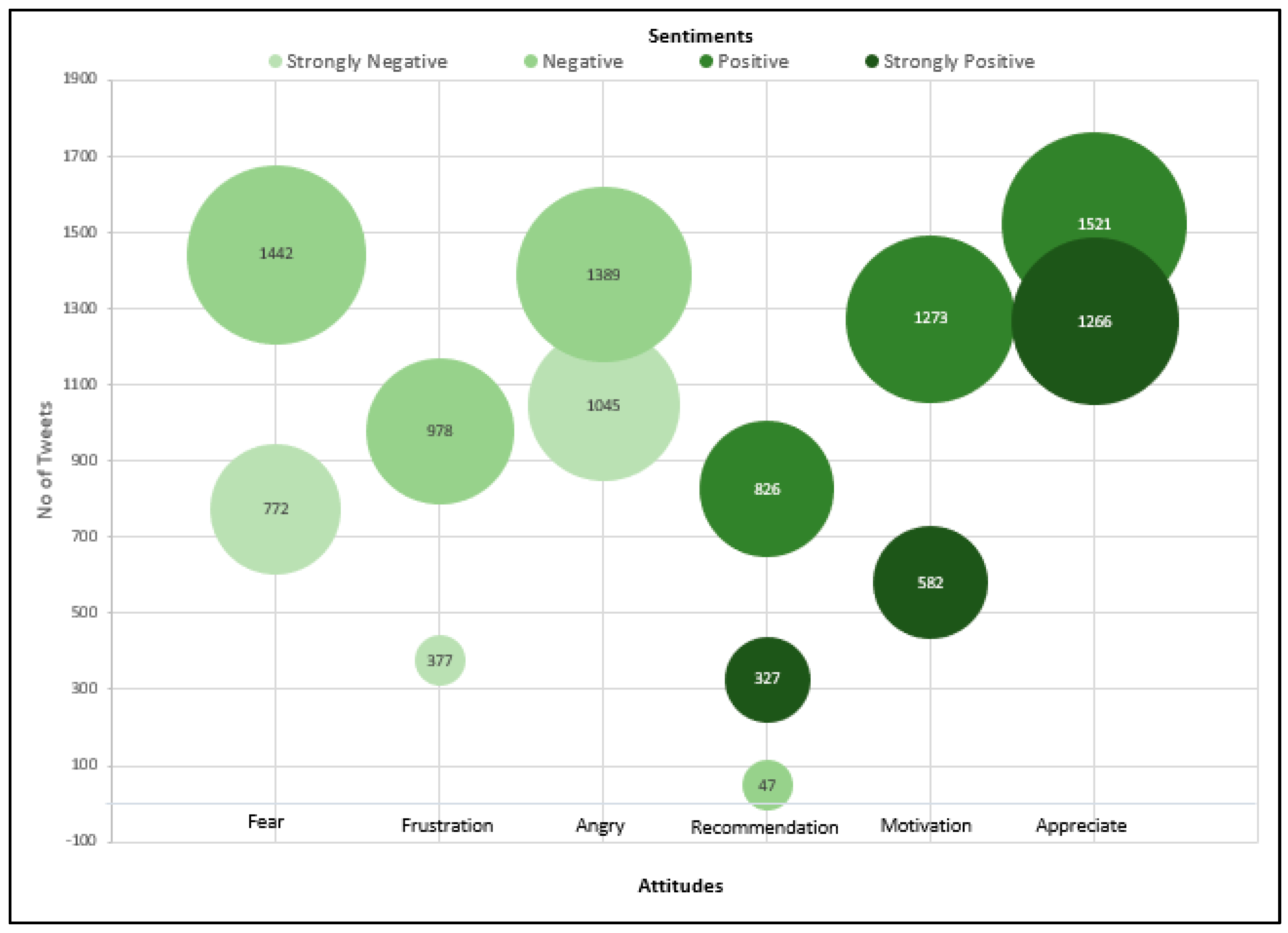

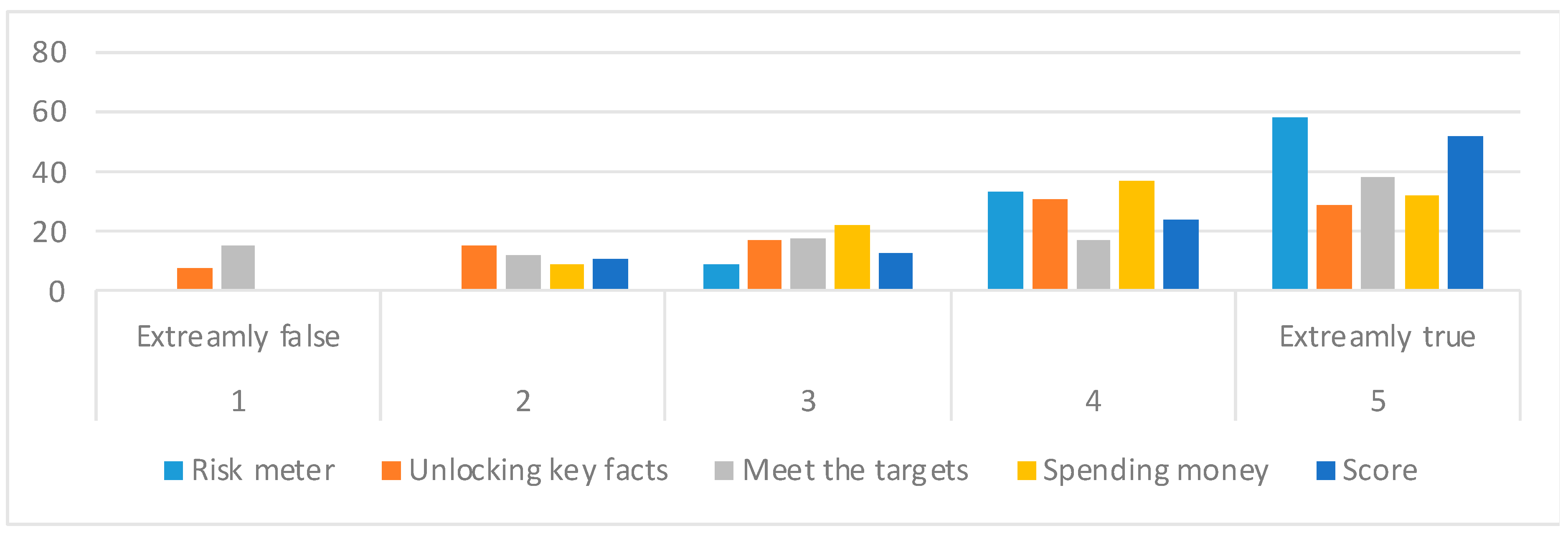
| Branch Path | Date and Time | Example Tweet |
|---|---|---|
| Education » Policy | 13 November 2019 13:25 | I think we should talk and learn about what caused these catastrophic bushfires so we can start putting an environment policy in place and prepare for the next catastrophic bushfires. Seems logical to me # AAEEACT #ClimateCrisis #NSWbushfires #qldbushfires |
| Education » Policy » Innovative | 14 November 2019 04:37 | Australia continues to experience unprecedented destruction from bushfires. Now is the time to harness our technological tools to help alleviate the problem, prevent future disaster, and make policies. Read more about innovations such as predictive mapping: https://t.co/00ig3acZ90, accessed on 17 May 2022 |
| Education » Policy » Evaluate | 25 November 2019 06:56 | Well simple evaluate on history shows we have experienced many bushfires outside of Summer! Maybe try doing your own research and make policies enacted to alleviate this |
| Education » Program | 1 August 2019 08:30 | Throughout the program students learnt how to safely operate fire equipment, how to check smoke detectors in their home, how and when to make a triple zero call, basic first aid, the importance of fire evacuation plans, stop, drop, and roll, and being bushfire ready. |
| Education » Disaster | 5 August 2019 09:29 | We know those who need education and support most before a disaster are the same who need most assistance post, we need to ensure interventions with vulnerable communities as priority in preparedness #resilienceconversations |
| Education » Crisis | 5 September 2019 05:32 | Australia already on frontlines of climate crisis. Prolonged drought. Flash flooding. Catastrophic bushfires, severe cyclones; heatwaves. Need to ramp up climate solutions and leanings; have a plan; fund a just transition |
| Education » Collaborate | 9 September 2019 09:32 | Collaborative Community Bushfire—Information Evening 11 October 2019 at the Kalamunda Performing Arts Centre. Come let’s study |
| Education » Knowledge | 17 October 2019 03:53 | Don’t miss Rod Rose our senior bushfire expert sharing his wealth of knowledge at this conference on Thurs 24 October next week |
| Education » Knowledge » Communities | 26 November 2019 23:42 | Are you bushfire-prepared? Mount Alexander residents are encouraged to attend this information session to help prepare them. #community #dontleaveittoolate #bushfirepreparedness |
| Education » Knowledge » Bushfire Volunteer Heritage | 3 December 2019 04:01 | monumental’ #NSW #bushfires have burnt 20% of #BlueMountains #worldheritage area. Had plenty of time to educate and inform authorities. Wasted |
| Education » Teaching and learning | 26 January 2020 22:40 | Wondering how well bushfire education could be effectively combined with water/drought (e.g., ‘he waves hazard’)—may be possible schools already developed expertise through their sustainable schools’ programs? |
| Sentiments | Words |
|---|---|
| Negative | angry, asthma, bad, blame, blood, bother, burn, catastrophic, crisis, cry, curse, danger, dangerous, devastate, die, dizzy, emergency, fear, FFS, fire, flee, frustrate, fuck, haze, horrible, ignore, inadequate, injured, lack, loss, miss, nervous, reckless, red, repugnant, severe, smoke, suffer, tear, terrify, waste, worse, WTF |
| Positive | appreciate, better, bless, brave, confidence, courage, donate, encourage, fine, firefighters, fortunate, fund, happy, help, hug, importance, invaluable, knowledge, lessons, love, modelling, okay, opportunity, plan, praise, prepare, priceless, ready, rescue, research, safe, smile, strong, support, survival, trust, victory |
| Sentiments | Attitudes | Words |
|---|---|---|
| Positive | Appreciations | appreciate, cheers, congratz, congratulations, best, better, bless, clap, donate, excellent, good, grateful, help, helpful, importance, praise, sincere, support, super, thanks, well, wow |
| Recommendations | download, access, advise, authority, away, consult, encourage, investigation, legal, management, plan, policy, proposal, propose, read, reckon, recommend, remember, research, SMS, stay, strategies | |
| Motivation | achieve, ambition, believe, commit, confidence, courage, determine, emotive, goal, inspire, motive, motivation, positive, target, trust, urge | |
| Negative | Fear | cry, dread, fright, injured, panic, plead, poor, pray, sad, scare, shake, unease, worry, yearn |
| Angry | accuse, angry, annoy, argue, blame, bullshit, condemn, curse, dangerous, depress, embarrass, enough, euphemism, ffs, lethargic, piss, question, wtf | |
| Frustrations | bizarre, criticize, deny, depress, disappoint, dismay, dissatisfy frustrate, ignore, mourn, regret, rumour, sad, shame, shock, sorrow, stress, unbelievable, unexpected, upset |
| Sentiment | Attitude | Date and Time | Example Tweet |
|---|---|---|---|
| Positive | Appreciations | 16 November 2019 07:38 | How good are horse people? Sydney Horse Transport to the rescue tomorrow to evacuate 4 horses from a friend’s farm at risk of bushfire. Learn from them. Thanks to driver Dave, and Dave from SHT. Thank you Hats off |
| Recommendation | 13 November 2019 04:22 | Locally, if you have not already done so, now is a good time to download the ACT Bushfire survival plan which will help you plan for the worst. https://t.co/Fbhh5iNy5Z, accessed on 17 May 2022 | |
| Motivation | 27 October 2019 08:16 | Motivational new campaign has been launched urging South Australians to make sure they have a bushfire action plan as we head into summer. The @CFSalerts says there is no room for complacency. | |
| Negative | Fear | 20 November 2019 07:33 | We were warned with all instructions to prepare for a day of danger, and it didn’t take long for those fears to be realize with more than 30 bushfires breaking out across the state |
| Angry | 17 December 2019 03:44 | No, I’m very angry. The pm is on holds overseas after declaring the unprecedented bushfires a national emergency. This is wrong. Are you going to call him out? Twitter is now inundated with tweets condemning Morrison’s sojourn overseas at this time of crisis. Educate Morrison. Where’s the ABC News? | |
| Frustrations | 15 November 2019 05:13 | WHAT!!???? NSW public servants at climate conference were told NOT to discuss link between bushfires history, climate change. The purpose of this conference was to Identify ways in which govt can plan adaptation to CC incl the management/planning for bush fires. So frustrating. Shame on you |
| Themes | Questions | Correctly Answered before the Game | Correctly Answered after the Game |
|---|---|---|---|
| Vacant Land Management | What do you do to dry bushes in the surroundings at the inception of a bushfire alert? Select the most appropriate answer | 40% | 90% |
| From the list given below, what can be used as fire breaks? Select the most appropriate answer | 60% | 87% | |
| Inhabited Land Management | What is the most appropriate item to be located to protect a house during bushfires? | 67% | 77% |
| What is the best place to locate a hospital in a bushfire-prone area? | 62% | 71% | |
| What should be the appropriate building material type for a house located in a bush fire area? | 38% | 71% | |
| Mark Yes/No [Land that has been cleared of trees creates a fire break] | 58% | 90% | |
| Building Material Management | Mark Yes/No [Hospitals and schools are important buildings in bushfires for people to take shelter] | 100% | 100% |
| C. Mark Yes/No [Storing flammable materials such as fuel, firewood at some distance helps to reduce fire risk] | 87% | 90% | |
| C. Mark Yes/No [It is better to keep low moisture trees rather clearing them] | 65% | 75% | |
| Community Management | List 5 actions that you would undertake to coordinate actions to bushfires | ||
| For what purposes can we use a community centre to reduce bushfire risk? | 52% | 81% | |
| What could be the role of a school in a bushfire? | 42% | 79% |
| Emotion or Attitude | Date and Time | Exemplar Tweet |
|---|---|---|
| Negative/Frustration | 13 November 2019 19:27 | Maybe they’ll be taken seriously now? Traditional owners predicted this bushfire disaster years ago, but ignored badly in conferences and workshops #disappointed #tradionedu #indigenous #nswfires |
| Positive/Recommendation | 14 November 2019 07:15 | I reckon social media should give more space to indigenous knowledge. I look forward to the day when we understand how the #land wants to be cared for—and ‘fire practitioners’ become the norm. I advise you to read the million-worth paper https://t.co/aOt72NkJxE, accessed on 17 May 2022 |
Publisher’s Note: MDPI stays neutral with regard to jurisdictional claims in published maps and institutional affiliations. |
© 2022 by the authors. Licensee MDPI, Basel, Switzerland. This article is an open access article distributed under the terms and conditions of the Creative Commons Attribution (CC BY) license (https://creativecommons.org/licenses/by/4.0/).
Share and Cite
Kankanamge, N.; Yigitcanlar, T.; Goonetilleke, A. Gamifying Community Education for Enhanced Disaster Resilience: An Effectiveness Testing Study from Australia. Future Internet 2022, 14, 179. https://doi.org/10.3390/fi14060179
Kankanamge N, Yigitcanlar T, Goonetilleke A. Gamifying Community Education for Enhanced Disaster Resilience: An Effectiveness Testing Study from Australia. Future Internet. 2022; 14(6):179. https://doi.org/10.3390/fi14060179
Chicago/Turabian StyleKankanamge, Nayomi, Tan Yigitcanlar, and Ashantha Goonetilleke. 2022. "Gamifying Community Education for Enhanced Disaster Resilience: An Effectiveness Testing Study from Australia" Future Internet 14, no. 6: 179. https://doi.org/10.3390/fi14060179
APA StyleKankanamge, N., Yigitcanlar, T., & Goonetilleke, A. (2022). Gamifying Community Education for Enhanced Disaster Resilience: An Effectiveness Testing Study from Australia. Future Internet, 14(6), 179. https://doi.org/10.3390/fi14060179








